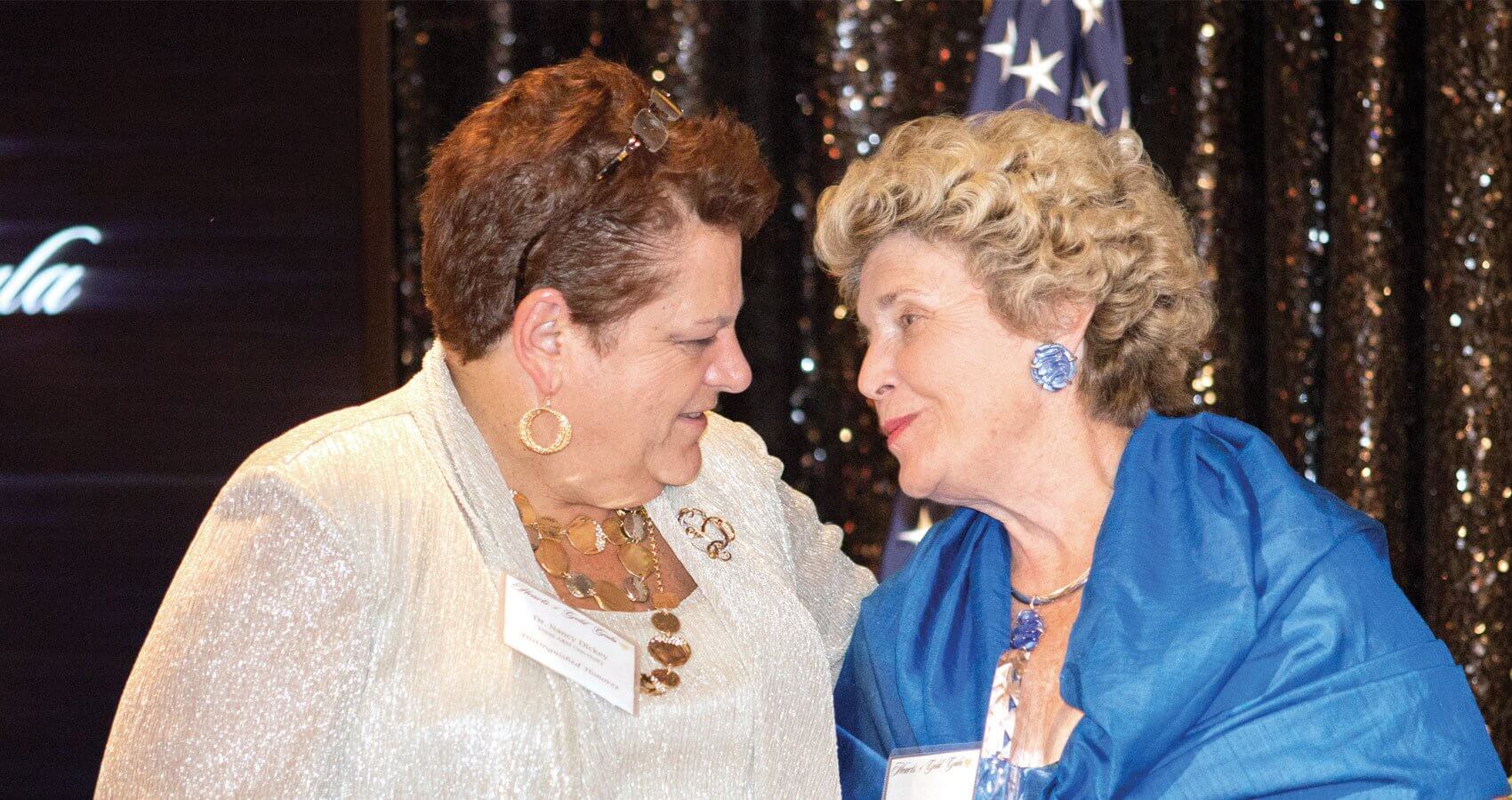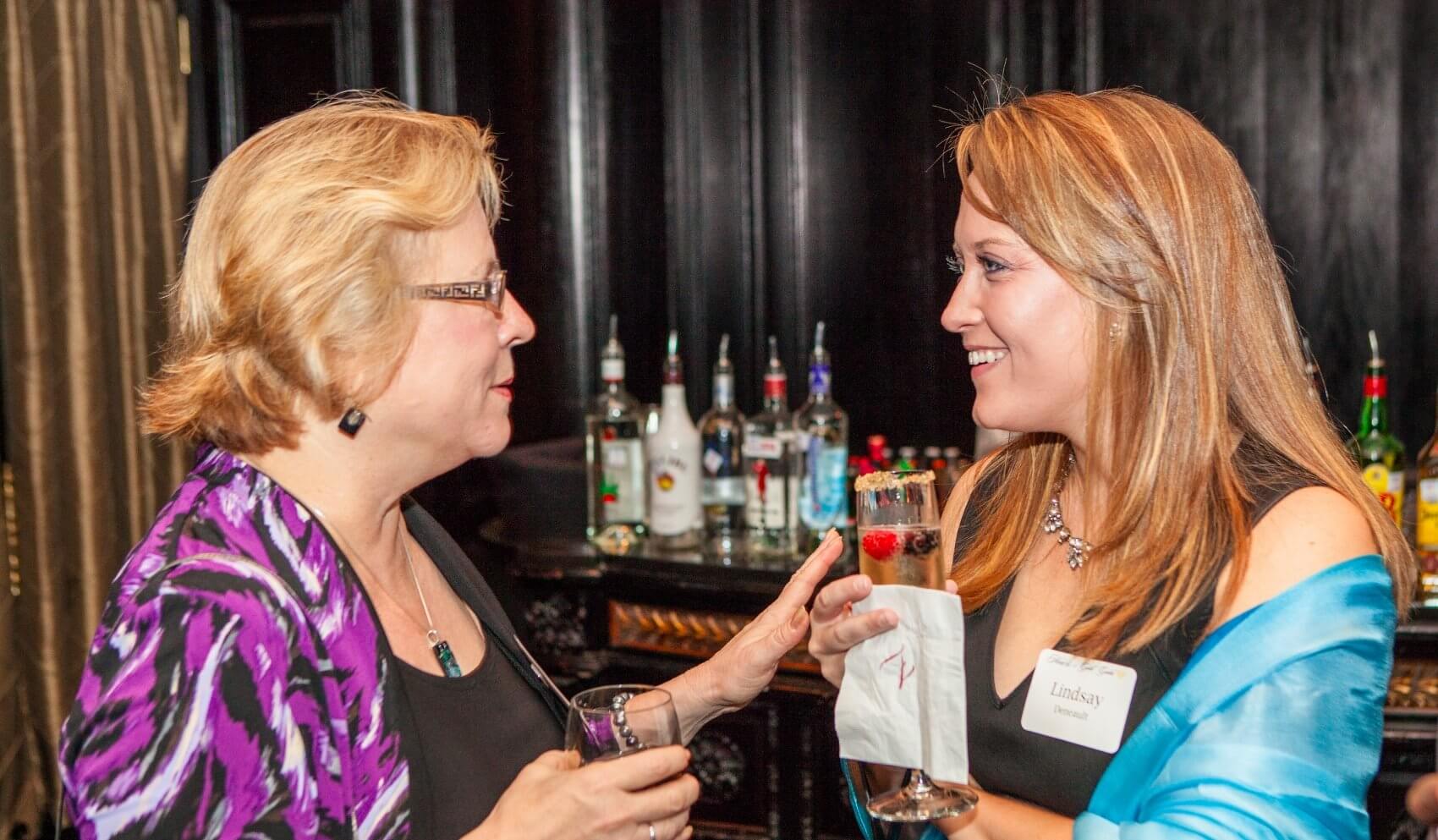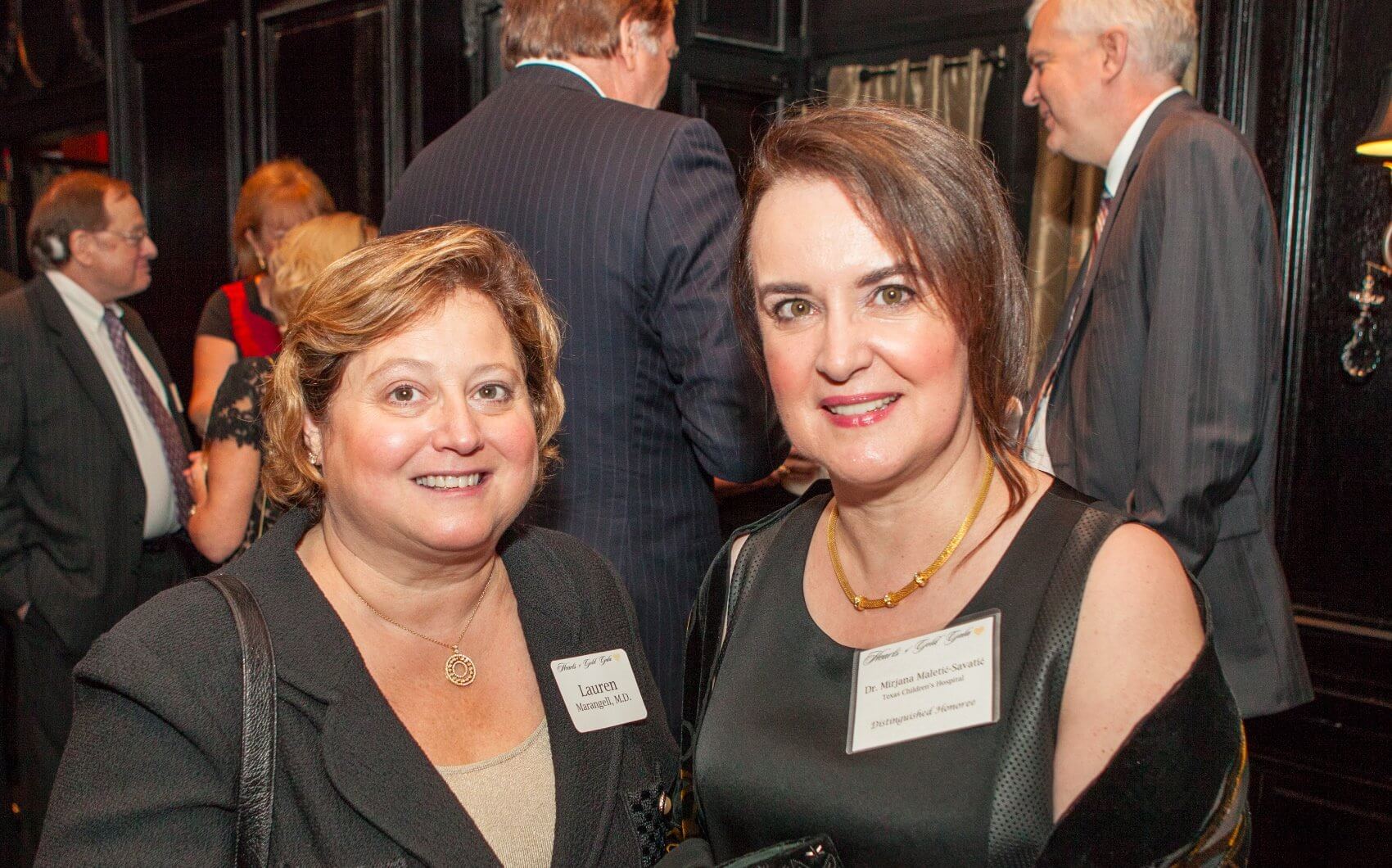Hearts of Gold Gala Honors Women in Health and Science

An award-winning researcher whose scope of involvement is as expansive as her ambition, encompassing everything from education to research to health policy. An educator and director, breaking through the barriers to interdisciplinary collaboration while synergizing efforts that had previously been fractured. Two trailblazers who sought to help physicians articulate their opinions with clarity and precision, launching a new discipline in the process. A neurologist whose lab is taking an integrative approach to the study of early developmental disorders, using patients’ own cells to re-create human neurons outside of the body. A president of a renowned health science center and an instrumental figure in expanding its programs and services to the surrounding community, delving into previously uncharted waters.
The list could continue endlessly. It’s no secret that the Texas Medical Center, and Houston in general, is brimming with talented and accomplished individuals, many of them pioneers in their respective fields. On September 19th, The Health Museum hosted the Hearts of Gold Gala, honoring 23 women for their contributions to health and medical science. Held at Hotel ZaZa and emceed by local news anchor Gina Gaston, the gala featured an evening recognizing a few of the noteworthy and impactful women of the Greater Houston area.
“We started thinking about all of the women that we have in the medical center who have been huge contributors in improving science and medicine,” said Elizabeth Torres, M.D., co-chair of the Hearts of Gold Gala and president of the Harris County Medical Society. “We saw that there was an extraordinary group of individuals who have been pretty much working quietly, accomplishing great works in different areas, and the idea was to honor these women and the strides that they’ve made in their respective arenas.”
“The Health Museum prides itself on engaging the greater Houston community with health and science education,” added Karen Tellepsen, co-chair of the Hearts of Gold Gala and chairman of The Health Museum Board of Directors. “Notable women like those being honored at this year’s gala have made significant contributions in health and medicine and we are privileged to recognize their accomplishments.”
According to Torres, distilling a list of notable honorees from the collective pool of talent in Houston was not an easy feat. “There are so many people who are deserving of recognition for what they’ve done, but we tried to select a group of people that provided a cross section of the work being done at various organizations in Houston and the medical center,” she said. “There are so many different honorees, from basic science to advances in genomics, and our focus was to honor them while providing inspiration for young students, showcasing the wealth of possibilities in science and medicine.” Ultimately, honorees were chosen for their contributions to health through patient care and safety, research, teaching, leadership, publication and community service.
For honoree Nancy W. Dickey, M.D., president emeritus of the Texas A&M Health Science Center, navigating unexplored territory in leadership was just part of the ebb and flow of her career trajectory. “It was more of a serendipitous journey than a planned destination,” she laughed. A family physician who delivered over 4,000 babies throughout the course of her career, Dickey’s desire to impact medicine on a broader level than daily patient care led her to the American Medical Association (AMA). In 1997, after serving for a year as chair of the board of trustees, Dickey was elected the first female president of the AMA. One of her first recommendations, a proposed patient’s bill of rights, is emblematic of her efforts to redefine and reshape medical care in the United States through the privileged perspective of a practicing physician.
“One of the joys and frustrations of family medicine is its very broad base—the perspective of looking not through a telescope, but at the entire breadth of issues, is a perspective that I have carried with me into academics,” said Dickey, who assumed the role of president of the Texas A&M Health Science Center and vice chancellor for Health Affairs of the Texas A&M University System from 2002 to 2012. “The fact that I had spent the overwhelming majority of my career in private practice means that while I had to listen care- fully to the academic perspective, which was new, I could bring a view- point that many lifelong academics had not experienced.”
Nelda Wray, M.D., MPH, co-director of Houston Methodist’s Center for Outcomes Research and a full member of the Houston Methodist Research Institute, is another honoree with a career similarly characterized by her expansive ambition and sphere of influence.
“I began my career educating medical residents, but at a certain point, I wanted to have more of an impact on the improvement of medical care than just training residents—I wanted to have a greater effect nationally on quality of care,” she said. “There’s a great joy in synthesizing teaching and implementation, but there’s a greater joy in creating new information.” After branching out into research, Wray served as the founding director of the Health Services Research and Development Center of Excellence at the Michael E. DeBakey VA Medical Center as well as the first section chief of Health Services Research at Baylor College of Medicine.
Throughout her career, Wray has filled a plethora of important policy roles, ranging from an appointment to the Texas Board on Aging, courtesy of Governor George W. Bush, to serving on the National Advisory Council for the U.S. Agency for Healthcare Research and Quality. “Once I went from education and training to research, it seemed that I needed to expand from research into policy to have the effect I wanted,” she said.
An award-winning researcher, Wray joined Houston Methodist Research Institute in 2008 after a long career at Baylor College of Medicine, where she served as professor of medicine and medical ethics.
Honoree Mary C. (Cindy) Farach-Carson, Ph.D., Ralph and Dorothy Looney Professor of Biochemistry and Cell Biology at Rice University and scientific director of the BioScience Research Collaborative (BRC), serves as another testament to the benefits of expanding the extent of your exposure.
“When I was getting close to being 50 years old, I had one of those, ‘Is this all there is?’ crises. I was an accomplished researcher and teacher, but I wanted the opportunity to do something totally different,” she said. “I realized that, despite the fact that I’m the daughter of a physician and a nurse practitioner, I had never spent time in a medical institution, walking the walk of a clinician. How could I truly know the influence I was having?”
During her first full-time sabbatical, Farach-Carson, also vice provost for translational bioscience at Rice University, had the opportunity to spend some significant time at a county community hospital group in Delaware. When she returned, she was “bilingual”—a self-professed convert to translational research—a perspective that she incorporated into her work at the University of Delaware, where Farach-Carson founded the Center for Translational Cancer Research. When she came to Rice in 2009, she was spurred to provide scientific leadership and vision for the BRC, and energized to foster an atmosphere of interdis- ciplinary and translational research. “With our programs, it’s about synergiz- ing parallel efforts,” said Farach-Carson. “We haven’t tried to create so many new plants rather than feed and water the ones that are there, and put them in the same garden when they need to be. It’s about tending all of those elements.”
Weaving together different disciplines into the fabric of transla- tional research is a major emphasis for honoree Mirjana Maletić-Savatić, M.D., Ph.D., neurologist in the Department of Pediatrics at Baylor College of Medicine and at the Jan and Dan Duncan Neurological Research Institute at Texas Children’s Hospital. Leading an interdisciplinary team, composed of everyone from mathematicians to chemists, Maletić-Savatić is focused on developing an integrative approach to the study of early developmental disorders, such as autism.
The team uses patients’ own cells to recreate human neurons outside the body and learn ways to diagnose developmental disorders much earlier in a child’s life. Maletić-Savatić and her team are especially interested in a phenomenon called neurogenesis— the process of the formation of new neurons in the brain.
“No man is an island,” she said, referring to the diversity of her lab’s expertise. “We cannot know everything, and one of my mottos is that ‘I can never know enough,’ so I assume that everyone is smarter about something than I am. I always listen to everyone. People have different types of expertise and look at the same problem in some- times surprisingly novel ways. I always try to emphasize how important it is to understand at least basic elements of different fields of science; joining expertise across the board is essential if you want to create reproducible and long-lasting results.”
Communicating across different levels of expertise is a pursuit that would define the career of Lois DeBakey, Ph.D., professor of scientific communication at Baylor College of Medicine. Alongside her sister Selma, DeBakey launched an entirely new discipline, scientific biomedical commu- nication, which encompassed critical reasoning, writing, editing, publishing, oral presentations, ethics and other related subjects. In the sixties, their courses at Tulane University School of Medicine represented the first curriculum-approved instruction in this field in any medical school—they have worked at Baylor College of Medicine since 1968.
“The purpose of medical writing and speaking is communication,” said DeBakey. “Lucid, concise, readable prose is easier to digest and interpret than ponderous logorrhea [excessive or stilted wordiness]. As Selma and I reviewed medical publications, replete with jargon, clichés and frozen forms, humorous images appeared in our minds of the literal depiction of the language used. We realized that was a useful didactic tool to relax our students and open their minds—it worked, and our classes were fun for both teach- ers and students. The courses became extremely popular, and we had more invitations nationally and internationally than we could accept.
“Genuine role models are always an asset if they motivate, stimulate, and inspire young people to think clearly, read critically, and adopt habits of honesty, integrity, compassion and altruism,” she added, speaking to the potential of the Hearts of Gold Gala to incite enthusiasm for medicine and science, and learning in general, among younger generations of women. The success of the honorees in attendance helped pave the way for aspiring physicians and researchers.
“Somebody said to me once that being the first is less important than ensuring that there’s a third and a fourth and a seventh and an eighth,” reflected Dickey. “Being first, you are exclusively aware that if you don’t perform satisfactorily, you will make it more difficult for someone else to come along. The opportunity to work side by side with someone of a different gender or race might painlessly address some preexisting biases. I think that having women, and anyone who breaks the mold, historically, in leadership positions is an opportunity to sensitize colleagues at the senior levels that there are more similarities than differences.”
For a full list of the Hearts of Gold honorees and their biographies, click here.








